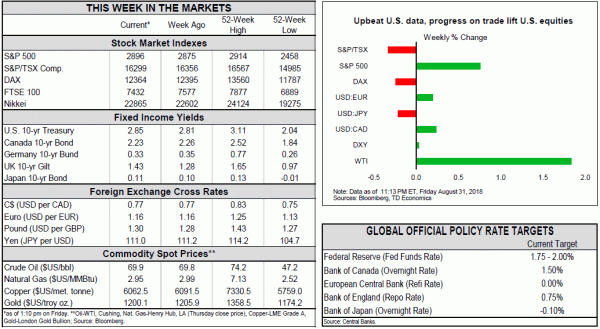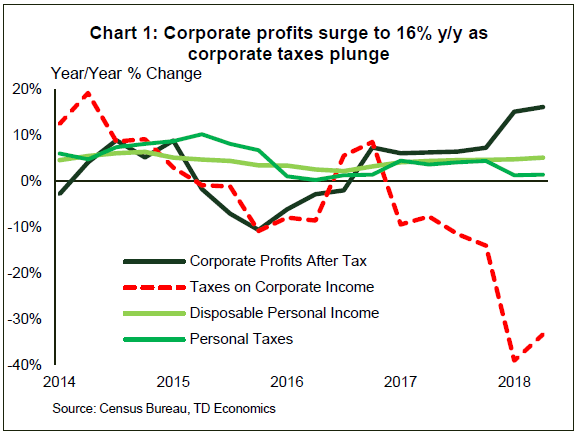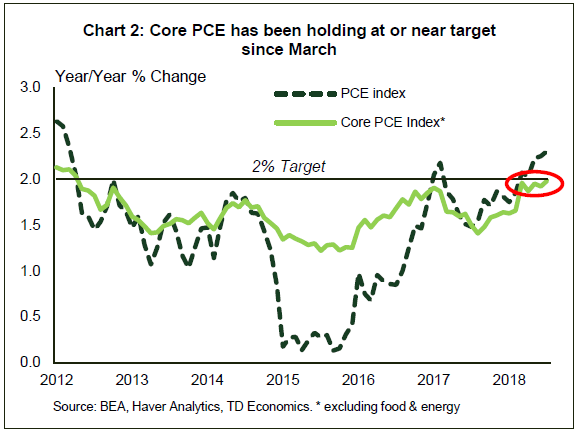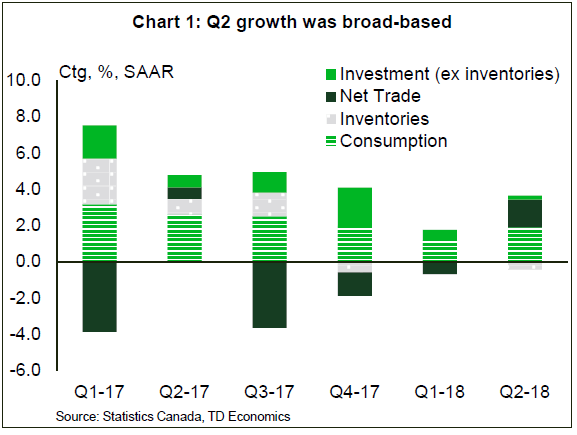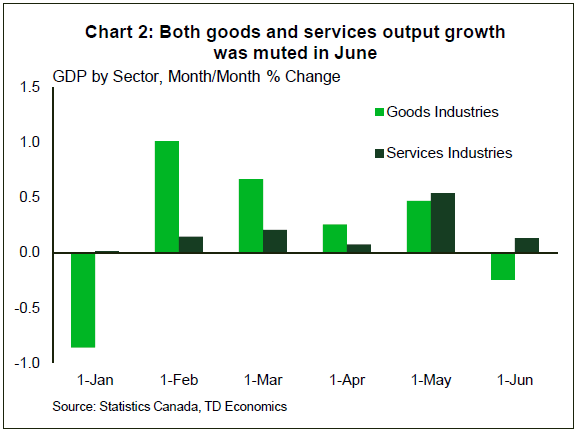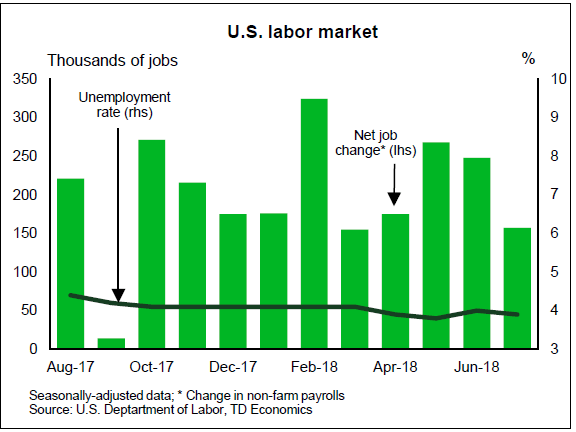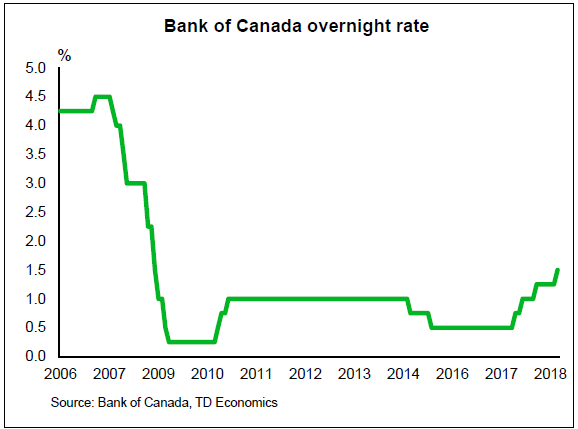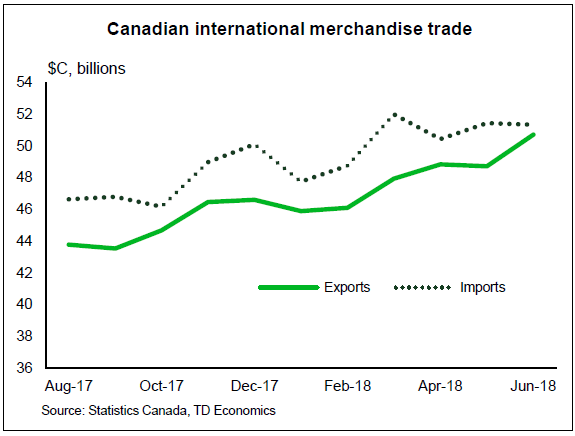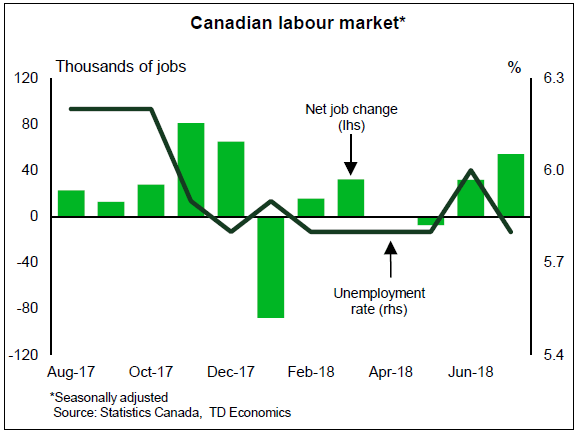The Weekly Bottom Line
U.S. Highlights
- Markets reacted positively to developments that the U.S. and Mexico had reached a trade deal. Details still need to be finalized, including Canada’s position. A revised, trilateral agreement looks unlikely to be achieved today.
- Data was broadly positive this week. Second quarter GDP was revised up slightly, and after-tax corp. profits rose to the highest y/y pace since 2012. A 0.2% July rise in real spending marks a good start to third quarter consumption.
- Core PCE rose 2% y/y in July. Steady inflation, holding at or near target since March, gives the Fed scope to continue on with its gradual reduction in stimulus. The next Fed hike is expected to come in September.
Canadian Highlights
- The U.S. and Mexico reached a new trade agreement, calling for Canada to join the deal by week’s end. The U.S.-Mexico pact includes both pluses and minuses for Canada.
- The Federal Court of Appeal ruled against approval of the Trans Mountain pipeline – a negative outcome for oil producers. However, there may yet be a path forward for the project, as the federal government remains committed to seeing it through.
- Second quarter GDP was nearly bang on Bank of Canada expectations, though muted activity in June points to a deceleration in growth for the third quarter.
U.S. – Inflation is Just Where the Fed Wants it to Be
The U.S.-Mexico trade agreement was welcomed by markets this week. Coupled with positive data flow, U.S. equities made further gains midweek. The agreement included augmented rules of origin for autos, strengthened intellectual property protections, and enhanced protections for labor and the environment. Details still need to be finalized, including Canada’s position. Today’s deadline for a tri-party agreement looks unachievable. An updated NAFTA agreement would allow the U.S. to shift focus back to resolving its trade dispute with China. News reports anticipate that President Trump will impose tariffs on an additional $200 bn of Chinese imports next week, helping pare back equity gains by week’s end.
Looking past shifting trade headlines, there was plenty to digest on the data front. Aside from pending home sales, which retreated for the 7th straight month in July and underscored the fact that housing remains a sore spot, data were broadly positive. Second quarter GDP was revised up slightly to 4.2%, beating expectations for a slight downgrade. Corporate profit data, released on the same day, added to the upbeat tone. Corporate taxes fell 33% from a year earlier, boosting after-tax profits 16% in Q2 – marking the best y/y gain since 2012. Tax cuts have indeed been bearing fruit, and they have been far more beneficial to businesses than households (Chart 1).
Personal income and spending data for July also proved positive. Nominal income (+0.3% m/m) and spending (+0.4%) recorded solid gains that were in line with prior months. On an inflation-adjusted basis, spending rose 0.2% m/m, extending the streak in real gains to five months and marking a good start to the third quarter. Last quarter’s 3.8% rebound in consumption will be hard to repeat. Nevertheless, upbeat consumer confidence, which is sitting at an 18-year high, along with continued employment gains and rising incomes all point to healthy consumer spending growth in the 2½ to 3% range for the rest of the year.
On prices, it was encouraging to see the Fed’s preferred measure of inflation holding at target. Core PCE rose 2% y/y in July, and has been in the 1.9% to 2% range since March (Chart 2). Inflation is not too hot, not too cold – it’s just right. This should allow the Fed to continue its gradual reduction in stimulus. As such, an almost certain September hike will likely be followed by another one in December.
Although the U.S. economy is experiencing a goldilocks moment, the same cannot be said for many of its international counterparts. Financial troubles in Turkey and Argentina have policymakers there battling plunging currencies and surging inflation. Argentina’s central bank hiked its policy rate to 60% this week – the highest in the world. All told, although the impact of trade policy uncertainty and turmoil in some emerging markets has been limited thus far, they remain clear downside risks to the domestic, and global, economic outlook.
Canada – Let’s Make a Deal
Trade talk and a setback for the Trans Mountain pipeline project dominated headlines this week. On Monday, the U.S. and Mexico came to an understanding on a new trade agreement. Canadian markets reacted favourably, with the loonie rising and the TSX rallying, viewing it as a positive step toward a NAFTA resolution. With the agreement came pressure on Canada to join the deal by week’s end. Doing so would allow out-going Mexican President Nieto to sign it before leaving office on December 1st. As of writing, no new deal has been reached, though the possibility of an agreement being achieved in short order remains.
The accord reached by the U.S. and Mexico includes some points amenable to Canada. For instance, it raises regional content requirements for automobiles to 75% (from 62.5%). Canadian automakers should be able to clear this hurdle. The U.S. also softened its stance on the sunset clause, in-line with earlier Canadian demands, with the new agreement carrying an effective 16-year term. This offers more certainty for businesses than the 5-year term the U.S. was pushing earlier in the process. One major point yet to be clarified relates to the potential for the U.S. to impose quotas on Canadian auto exports, similar to what they have reportedly negotiated with Mexico. Such an outcome would be negative for Canada’s auto industry.
Later in the week, news broke that the Federal Court of Appeal quashed cabinet approval of the Trans Mountain pipeline. This is a negative development for oil producers, as the pipeline offered the chance to diversify export markets and add much-needed pipeline capacity. However, there is a ray of hope, as the federal government remains committed to the project. As such, there may yet be a path to completion, albeit with significant delay.
Also in the spotlight was the second quarter GDP report. The economy expanded at an above-trend 2.9% (annualized) pace in the second quarter – almost bang on the Bank of Canada’s latest forecast. Growth was broad-based, with several expenditure categories contributing positively to the headline (Chart 1). However, business investment grew at its slowest pace in six quarters, which is certainly eyebrow-raising. The monthly data was also less encouraging, with GDP flat in June, owing to a modest gain in the services sector that was offset by a decline in goods output (Chart 2). This provides a soft handoff to the third quarter, consistent with our forecast calling for firm, but slower growth.
Events this week have likely done little to move the dial for the Bank of Canada, at least in the short-term. While developments on the trade front have so far been encouraging, much is left to be negotiated. Moreover, the Q2 GDP report, while solid, came in as the Bank expected. Our view is that the most likely timing for the next hike remains October. Markets seem to agree, putting the odds at over 80% as of this morning.
U.S.: Upcoming Key Economic Releases
U.S. Employment – August
Release Date: September 7
Previous: 157k, unemployment rate: 3.9%
TD Forecast: 190k, unemployment rate: 3.8%,
Consensus: 194k, unemployment rate: 3.8%
We expect payrolls to bounce back by 190k in August as the prior moderation in services unwinds. Solid growth should continue to be underpinned by strength in goods-producing jobs, in line with ISM jobs indicators. However, August payrolls tends to underperform ADP as well as consensus forecasts, so we lean against a strong +200k print. On the back of the solid trend in payrolls (221k 6m average), we expect the unemployment rate to dip back to previous lows of 3.8%. On wages, we expect average hourly earnings to rise 0.2% m/m, keeping the y/y pace at 2.7%. The reference week (with the 12th of the month landing on a Sunday) implies a weak m/m point though also a wide dispersion (-0.1% to 0.4%). Given that the prior July increase was relatively strong (0.3%), we are biased toward a relatively modest August rise.
Canada: Upcoming Key Economic Releases
Bank of Canada Rate Decision
Release Date: September 5
Previous: 1.50%
TD Forecast: 1.50%
Consensus: 1.50%
We expect the Bank of Canada to keep policy rates unchanged at its September meeting. Although the Bank will no doubt continue to emphasize a gradual normalization path with a heavy focus on data dependency, we expect the Bank will be encouraged by economic data over the last six weeks. Notably, the housing market has attained a modicum of stability, while Poloz has consistently stated that the Bank will only incorporate tariffs into their forecast when they are implemented. Consequently, we expect to the communique to have a relatively optimistic tone. Residual expectations for a September rate hike almost entirely disappeared after the slightly below consensus reading on Q2 GDP, but markets are still firmly anchored around tightening in October. We expect the September communique to effectively (though not explicitly) affirm market expectations.
International Merchandise Trade – July
Release Date: September 5
Previous: -$0.63bn
TD Forecast: -$1.0bn
Consensus: -$1.0bn
The international merchandise trade deficit is forecast to widen to $1.0bn in July, giving back some of the previous months’ narrowing as imports rebound. Exports should see little change as a pullback in crude oil shipments, caused by shutdowns in the oil sands, offsets stronger non-energy exports. Motor vehicles are the main driver for the non-energy component as presaged by a pickup in US imports. On the other side of the equation, imports will see a drag from retaliatory tariffs on steel, aluminum and a broad range of consumer goods, resulting in only a modest increase for the month.
Canadian Employment – August
Release Date: September 7
Previous: 54.1k, unemployment rate: 5.8%
TD Forecast: 0k, unemployment rate: 5.9%
Consensus: 0k, unemployment rate: 5.9%
TD looks for employment to remain unchanged in August on a pullback in the public sector. The public sector contributed 50k of a total 54k jobs created last month, and the regional concentration (nearly all were located in Ontario) suggests the presence of a one-off that will unwind. Public sector weakness will likely show up in the industry breakdown via education and health care, which combined to add 67k workers in July for the strongest pace of hiring on record. Private employment should benefit from a rebound in the goods sector after manufacturing and construction shed a combined 30k jobs in July. Our forecast is consistent with the unemployment rate rising to 5.9% while wage growth for permanent workers should edge lower to 2.9% y/y on base-effects.




